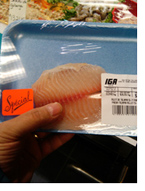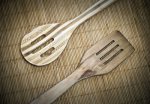Toxic plastics to remove from your home as soon as you can.
There are reasons to cut back on the use of all plastics in our homes, but there are three classes of plastic which comprise a clear and immediate threat to your health.
These are the plastics to get out of your kitchen, and elsewhere in your home, right now.

Bad Plastic #3 – Polyvinyl Chloride
Polyvinyl Chloride is more commonly known as PVC.
PVC contains phthalates. Phthalates are chemicals which are included because they help make the plastic flexible. That’s why garden hoses contain PVC, as do shower curtains, some cling wraps, teething rings, baby’s vinyl toys and some squeezable bottles.
The trouble is, phthalates are highly toxic and small doses migrate from the PVC to anything that touches it – whether that be food, drink, shampoo or a baby’s mouth.
Phthalates are endocrine disruptors. They mimic estrogen. Because phthalates resemble estrogen, they can mimic or block estrogenic effects in the body.
Endocrine disruptors are associated with a number of health problems that are on the rise on the U.S. and worldwide, including breast cancer, prostate cancer, infertility and heart disease.
By the way – you know that “new car smell” loved by so many people? What you are smelling, and inhaling into your lungs, are phthalates.
Bad Plastic # 6 – Polystyrene

Polystyrene is used in disposable coffee cups, take-out food containers, egg cartons and the packaging of meats, cheeses and other foods in your local supermarket.
What is the problem with polystyrene?
It contains styrene, also known as vinyl benzene. The US Environmental Protection Agency, which is notoriously conservative when it comes to associating plastics with any ill-effects, has described styrene as "a suspected carcinogen" and "a suspected toxin to the gastrointestinal, kidney, and respiratory systems, among others."
Styrene is also listed by the World Health Organization as a possible carcinogen.
When you next drink coffee from a polystyrene cup, also keep in mind that the release of styrene is increased when polystyrene is heated.
Another important thing to know about polystyrene is that it isn’t always used in its foamed form. Polystyrene is also used in a solid form, as a clear or colored plastic. Solid polystyrene is used, for example, in disposable cutlery, some yogurt cups and clear containers for cakes and other baked items.
Bad Plastic #7 – Polycarbonates
The number 7 designation actually includes pretty much every plastic that isn’t included in 1-6.
However, most plastics marked with the number 7 are polycarbonates.
Polycarbonates contain BPA, also referred to as bisphenol-A.
BPA is highly toxic and has been banned from use in most plastic products by both the European Union and Canada. But not in the US. (The first state to legislate against the use of BPA in some products was Minnesota, in January 2010.)
Where will you find BPA?
If you live in the US, you will find it in many baby bottles, sports bottles, water cooler bottles and in food and drink containers.
You can often figure out plastics which contain BPA because they are rigid, and almost unbreakable. That is why BPA is found so frequently in baby bottles and sports drink bottles. If you drop them, they don’t break.
A study by the CDC estimated that 92.6 percent of Americans age 6 and above had measurable BPA in their bodies, and the number one source of that BPA is the plastic coating on the inside of cans. If you eat canned food, you have been absorbing BPA.
As with phthalates, BPA is an endocrine disruptor, with all the same dangers described in the section on Plastic #3 above.
Even if you don’t live in the US, don’t be complacent. Polycarbonate plastic is also used in common kitchen appliances, like coffee makers.
You might also be interested in...:
Recent Articles
-
Why the American Chemistry Council sponsored the 5th International Marine Debris Conference in Honolulu, Hawaii.
Apr 26, 18 09:58 AM
I have written before about the American Chemistry Council, and how hard it works to defend the ongoing production of all plastics, regardless of the environmental -
BPA-free food processors and blenders.
Dec 28, 16 10:21 PM
If you are looking for a BPA-free food processor or blender, you have a few choices. -
Alternatives to plastics in your kitchen – glass, wood, stainless steel and cera
Dec 28, 16 09:49 PM
To keep your kitchen food-safe, BPA-free, phthalates-free and PVC-free, switch to traditional alternatives like glass, stainless steel, wood and ceramics.
Recent Updates
-
Why the American Chemistry Council sponsored the 5th International Marine Debris Conference in Honolulu, Hawaii.
I have written before about the American Chemistry Council, and how hard it works to defend the ongoing production of all plastics, regardless of the environmental -
BPA-free food processors and blenders.
If you are looking for a BPA-free food processor or blender, you have a few choices. -
Alternatives to plastics in your kitchen – glass, wood, stainless steel and cera
To keep your kitchen food-safe, BPA-free, phthalates-free and PVC-free, switch to traditional alternatives like glass, stainless steel, wood and ceramics. -
Toxic plastics contain dangerous chemicals like bisphenol-A, phthalates and PVC
Plastic food packaging and food storage containers containing bisphenol-A, phthalates and PVC are toxic, and bad plastics to use in your kitchen.







